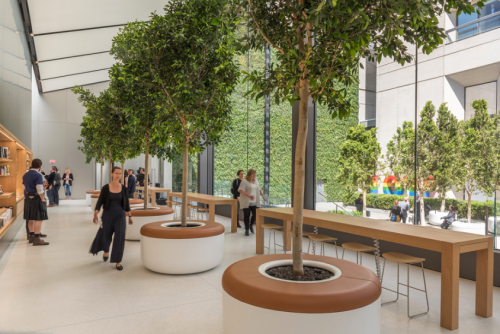Contemporary offices are increasingly introducing aspects of our natural environment into workplaces in a bid to enhance the health and productivity of staff. Office designs that focus on connecting the workspace to the outside environment are considered ‘biophilic’ in their approach. Biophilic design is a concept that came to fruition back in the 1980s by a biologist named Edward O. Wilson. Mr Wilson revealed that humans have an innate desire to “affiliate with other forms of life”.
Subsequently, with the rapidly increasing urbanisation of homes and workplaces, biophilic design in contemporary offices has become a hot topic, fusing the outside world with 21st century commercial properties. In 2001, the National Human Activity Pattern Survey revealed that the vast majority of humans spend 90% of their time indoors. Given that this figure has likely increased in the last decade, the need to bring the outdoors in and design indoor workplace environments that clearly reference and celebrate nature is greater than ever.
This survey also tallies with a report commissioned by Ambius, which found that 35% of office workers get less than 15 minutes of outdoor time during a typical working day. When it comes to workplace productivity, employee exposure to the outside environment is proven to make staff happier and more content. Increasing levels of natural daylight into your premises and introducing a healthy dose of foliage into your office can improve mental alertness with increased melatonin and vitamin D.
How to improve your office design using the biophilic concept:
- Consider introducing ‘natural’ colours into your office
A contemporary office that adheres to the principles of biophilic design is one that introduces natural, ‘earthy’ colours to your environment. Whether it’s various shades of greens, browns, blues or whites, these are biophilic colours that help interior design become less of a functional discipline and more of a way to improve employees’ mental and physical wellbeing.
- Natural finishes and furnishings
Whether it’s office furniture or communal finishes in kitchen or social areas, it’s a good idea to try and incorporate as many natural materials into your office space as possible. You could consider wooden desks or shelves or stone or granite worktops. All of these materials are an effective means of reconnecting your workspace with the great outdoors.
- Make the most of your property’s natural light
A truly biophilic office space is one that encourages abundant levels of natural light into working areas. It doesn’t matter how it’s achieved. It could be through the use of floor-to-ceiling windows, rooflights or central atriums; anything that can help to keep a ceiling on the amount of artificial lighting required. Too much artificial lighting can have damaging consequences on employees’ eye health. It is said that the benefits of natural light from side windows almost vanishes if workstations are positioned more than 25 feet away from windows. This is something to bear in mind when deciding on your biophilic office layout.
- Infiltrate your office with real and artificial greenery
The introduction of greenery and foliage into your workspace can have a really positive impact on the mental and physical wellbeing of staff. Real plants can mitigate levels of CO2 in your environment and enhance people’s sense of wellbeing. It doesn’t have to be a ‘loud’ or ‘bold’ use of greenery. In fact, some people try to incorporate it subtly, using ‘living walls’ that act as office partitions.
Biophilic interior designs don’t need to cost the earth. With a little innovation and intuition, workspaces can reconnect with the outside world regardless of your budget or resources.
Pall Mall Estates have a wide range of low cost commercial properties across the UK. Take a look at our available spaces here or get in touch with our experienced team here.
—
Pall Mall Estates have a wide range of low cost commercial properties across the UK.
Take a look at our available spaces here or get in touch with our experienced team here.







